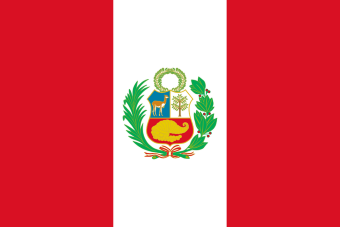Peru Military Power Ranking 2025
MPR Rank: 61st
MPR SCORE: 550
MPR Index: 0.2204 (1.0000 is perfect)
Reverse MPR Index: 0.7389 (0.0000 is perfect)
Z Score: +0.264 (standard deviations above the mean)
Overview
Peru ranks 61st in the 2025 Military Power Rankings (MPR). As a South American nation with vast mountainous terrain, dense jungle regions, and a long Pacific coastline, Peru’s military is tailored for territorial defense, internal security, and maritime protection. Despite limited modernization and constrained power projection, Peru maintains capable jungle warfare units, a stealthy submarine fleet, and a growing role in regional security cooperation, allowing it to defend its borders and contribute to multinational missions.
Strengths:
Terrain-Adapted Force with Asymmetric Capabilities
Jungle and Highland Warfare: Peru’s ground forces are trained for combat in Amazonian jungles and Andean highlands, providing unique operational resilience in difficult environments.
Submarine Fleet: The Peruvian Navy operates Type 209 submarines, offering stealth patrol capability along South America’s Pacific corridor and enhancing its maritime deterrence.
Counterinsurgency and Special Forces: Elite units such as Comando Chavín de Huántar specialize in hostage rescue, anti-terrorism, and counter-narcotics, built from decades of experience fighting domestic insurgencies.
Peacekeeping and Regional Integration: Peru participates in UN missions and multinational exercises like RIMPAC and UNITAS, increasing its interoperability with regional and global partners.
Why Peru Is Ranked 61st
1. Limited Defense Budget and Aging Inventory
Peru’s military modernization is slowed by fiscal constraints and outdated systems.
Defense spending remains below 1.5% of GDP
Many platforms, including MBTs, IFVs, and aircraft, date to the 1980s and 1990s
2. No Strategic Mobility or Long-Range Strike
Peru lacks force projection capacity beyond its borders.
No strategic airlift, aerial refueling, or guided missile capabilities
Maritime forces lack amphibious or expeditionary support vessels
3. Industrial and Technological Limitations
Peru’s defense sector remains heavily import-dependent.
No indigenous development of advanced C4ISR or air defense systems
Vulnerability to foreign supply chain disruption in prolonged conflict
Conclusion
Peru fields a regionally capable, terrain-savvy defense force with specialized skills in counterinsurgency, jungle warfare, and maritime patrol. However, in the context of the MPR—which emphasizes autonomous warfighting capability, modernization depth, and strategic mobility—Peru ranks 61st, held back by budgetary limits, aging equipment, and lack of extended reach.
Military Strength and Force Projection:
Active Military Personnel: 120,000 (IISS 2023)
Reserve Personnel: 60,000 (CIA World Factbook)
Paramilitary Forces: 90,000 (Peruvian National Police)
Army Personnel: 85,000
Navy Personnel: 20,000
Air Force Personnel: 15,000
Ground Forces
Main Battle Tanks (MBTs): 400+ (T-55, T-90)
Armored Fighting Vehicles (AFVs): 1,000+
Artillery (Towed and Self-Propelled): 300+
Air Force
Combat Aircraft: 40+ (SIPRI 2023)
Helicopters: 50+
Transport Aircraft: 25+
Aircraft Breakdown:
MiG-29 Fighter Jets: 16
Mirage 2000 Fighter Jets: 12
C-130 Hercules: 5 (transport)
Naval Forces
Submarines: 6 (Type 209)
Frigates: 8 (Carvajal-class)
Corvettes: 4
Patrol Vessels: 20+
Fast Attack Craft: 10+
Missile Capabilities
Peru has limited missile capabilities, focusing on short-range defense systems and anti-ship missiles for coastal defense. The country does not possess strategic missile systems but aims to improve its missile defense capabilities as part of its naval modernization strategy.
Strategic Partnerships
Peru maintains strong defense ties with the United States and other Western nations, frequently participating in joint military exercises. It has also forged partnerships with neighboring South American countries, focusing on regional security and counter-narcotics operations. Peru continues to invest in defense modernization programs to enhance its military readiness.
Military History & Combat Experience
Peru’s military history is defined by a transition from 19th-century interstate warfare to 20th-century border clashes and decades of internal counterinsurgency operations. While Peru has not engaged in large-scale modern warfare in recent decades, its armed forces have accumulated extensive experience in jungle warfare, high-altitude operations, and domestic security missions, shaping a force specialized in rugged territorial defense.
War of the Pacific (1879–1883): Peru fought alongside Bolivia against Chile in one of South America's most consequential wars. Despite a strong initial resistance and the heroism of naval icons like Admiral Miguel Grau aboard the Huáscar, Peru suffered significant territorial losses, including the provinces of Arica and Tarapacá, and occupation of Lima. The defeat deeply influenced Peru’s later defense posture and naval priorities.
Ecuador–Peru Border Conflicts (1941, 1981, 1995): Peru and Ecuador clashed multiple times over disputed Amazonian territories. The most notable conflict was the Cenepa War in 1995, a high-altitude engagement in the Cordillera del Cóndor. Peru deployed special forces and rotary-wing aircraft to remote jungle positions, gaining valuable experience in mountain warfare and tactical air mobility.
Internal Conflict with Shining Path (1980s–1990s): Peru endured a prolonged and violent insurgency led by the Maoist guerrilla group Sendero Luminoso (Shining Path). The conflict forced the Peruvian military to develop expertise in counterinsurgency, intelligence-driven operations, and civil-military coordination, particularly in the rural Ayacucho region. The 1997 Chavín de Huántar hostage rescue operation remains a hallmark of Peruvian special forces capability.
Counter-Narcotics and VRAEM Operations (2000s–Present): Following the insurgency, remnants of Shining Path reconstituted as narco-terrorist factions in the VRAEM (Valle de los ríos Apurímac, Ene y Mantaro) region. The military continues to conduct coordinated joint operations with police units, using riverine patrols, jungle warfare battalions, and special operations teams to maintain state presence and suppress illegal drug production.
Peacekeeping and Regional Exercises (2000s–Present): Peru has contributed to UN peacekeeping operations, including missions in Haiti, Lebanon, and the Democratic Republic of Congo. It also participates in regional naval exercises such as UNITAS and multinational engagements like RIMPAC, reinforcing interoperability and maritime coordination.
Peru’s military experience is defined by its hard-earned expertise in jungle warfare, highland operations, and asymmetric threats. While not engaged in large-scale conventional war since the 1990s, its armed forces remain seasoned in internal security, regional deterrence, and multilateral cooperation, reflecting a resilient and regionally capable defense posture.
General Information
Demographics and Geography
Population: ~34.2 million (2024 est.)
Population Available for Military Service: ~11.5 million (males and females aged 18–49)
Geographic Area: 1,285,216 km²
Land Boundaries: 7,461 km
Bordering Countries: Ecuador, Colombia, Brazil, Bolivia, Chile
Coastline: 2,414 km
Climate: Varies from tropical in the east to dry desert in the west; temperate to frigid in the Andes
Terrain: Western coastal plain, high Andes mountains in center, Amazon Basin in east
Natural Resources: Copper, silver, gold, petroleum, timber, fish, iron ore, coal, phosphate, natural gas
Proven Oil Reserves: ~580 million barrels
Proven Natural Gas Reserves: ~14 trillion cubic feet
Economic Indicators
Defense Budget (2025): ~$2.6 billion USD
Defense Budget as % of GDP: ~1.2%
GDP (PPP): ~$560 billion USD
GDP per Capita (PPP): ~$16,000
External Debt: ~$75 billion USD
Military Expenditure Trend (last 5 years): Generally stable with moderate annual increases for modernization
Military Infrastructure and Readiness
Military Service Obligation: Voluntary; selective conscription exists but rarely enforced
Primary Defense Focus: Border security, internal stability, narcotics interdiction, disaster response
Military Industry Base: Limited; includes arms repair, vehicle refurbishment, and small arms manufacturing
Cyber/Electronic Warfare Capability: Minimal but expanding
Nuclear Warhead Inventory: None (non-nuclear state)
Major Military Districts / Commands: Northern, Central, Southern, Eastern military regions under Joint Command of the Armed Forces
Missile Inventory Highlights: Short-range artillery rockets and anti-aircraft systems; no strategic missile assets
Reservist Call-up Readiness / Timeline: Moderate readiness; 30–60 days mobilization timeframe
Reservist Force Size: ~90,000
Space, Intelligence, and Strategic Infrastructure
Space or Satellite Programs: Owns observation satellites (PeruSat-1); limited domestic launch capability
Military Satellite Inventory: 1 optical reconnaissance satellite (PeruSat-1)
Intelligence Infrastructure: National Directorate of Intelligence (DINI), military and police intelligence branches
Intelligence Sharing Partnerships: Bilateral agreements with U.S., Brazil, Colombia, and regional defense cooperation
Airports (Total): ~234
Major Military Airports: Lima (Callao), Arequipa, Iquitos, Piura, Talara
Naval Power and Maritime Logistics
Merchant Marine Fleet: ~100 vessels
Major Ports: Callao, Paita, Matarani, Ilo
Naval Infrastructure: Moderate; includes submarines, frigates, patrol boats, amphibious craft
Naval Replenishment Capability: Limited blue-water support; capable of regional deployments
Domestic Mobility and Infrastructure
Railway Network: ~1,900 km
Roadways: ~175,000 km
Energy and Fuel Logistics
Oil Production: ~40,000 barrels per day
Energy Imports: Moderate oil imports; growing domestic gas output
Strategic Petroleum Reserves: Maintains small-scale reserves for emergency usage
Defense Production and Strategic Forces
Domestic Defense Production: Small arms, uniforms, maintenance services, basic vehicles and vessels via FAME and SIMA
Military Installations (Domestic): Major bases in Lima, Arequipa, Piura, Iquitos, and Cusco
Military Installations (Overseas): None
Foreign Military Personnel Presence: Occasional training and advisory presence (e.g., U.S. Southern Command)
Defense Alliances: No formal alliances; regional defense agreements via UNASUR and cooperation with U.S.
Strategic Airlift Capability: Limited; operates C-27J Spartan, An-32, and transport helicopters
Wartime Industrial Surge Capacity: Low; dependent on imports and allied logistical support
Research and Industry Support
Defense R&D Investment: Modest; primarily through military technical institutes and state industries
Key Wartime Industries Beyond Defense: Petroperú (energy), Graña y Montero (infrastructure), logistics contractors, food/agro processing
Political and Administrative Structure
Capital: Lima
Founding Date: July 28, 1821 (independence from Spain)
System of Government: Unitary presidential constitutional republic



